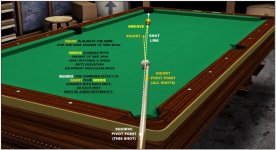A couple of instructors (one of them in the top tier of the world ranking list) have told me to shorten my bridge length. They are recommending no more than 8" and often much less. I didn't question this as I know they were trying to improve my accuracy so I have tried it for several months. The goal was to get me to hit a more precise spot on the cue ball. They said the pros can do this with a long bridge but I would benefit from a shorter bridge.
Watching some final table world championship matches I noticed almost no one was using that short a bridge. Many top players and instructors use quite a long bridge. The pros seem to vary quite a bit depending on the type of shot. I notice they will extend quite a bit if they can incorporate a rail. For short soft shots they may well use a short bridge but even then, some don't.
So I tried shooting with a longer bridge just to see what would happen. I was surprised to find I cut several missed shots off some practice drills and felt much more in control of my stroke. The things I noticed in particular are: 1. I could see better. By getting further down and further from the cue ball and object ball I could see them both at the same time more often and line them up better (I am 67 years old and not as flexible as I used to be). 2. My stroke was smoother and longer. I could draw more consistently. 3. My speed control was better. Just because I COULD take a long stroke didn't mean I had to. I could simply draw back a shorter distance for softer shots. When I needed more pace I could build the speed more gradually and judge the overall speed better.
The only real information I have seen on bridge length was Dr. Dave's discussion of its affect on the amount of correction when using BHE.
Is there a best bridge length and is it the same for all players? Your comments are welcome.
Watching some final table world championship matches I noticed almost no one was using that short a bridge. Many top players and instructors use quite a long bridge. The pros seem to vary quite a bit depending on the type of shot. I notice they will extend quite a bit if they can incorporate a rail. For short soft shots they may well use a short bridge but even then, some don't.
So I tried shooting with a longer bridge just to see what would happen. I was surprised to find I cut several missed shots off some practice drills and felt much more in control of my stroke. The things I noticed in particular are: 1. I could see better. By getting further down and further from the cue ball and object ball I could see them both at the same time more often and line them up better (I am 67 years old and not as flexible as I used to be). 2. My stroke was smoother and longer. I could draw more consistently. 3. My speed control was better. Just because I COULD take a long stroke didn't mean I had to. I could simply draw back a shorter distance for softer shots. When I needed more pace I could build the speed more gradually and judge the overall speed better.
The only real information I have seen on bridge length was Dr. Dave's discussion of its affect on the amount of correction when using BHE.
Is there a best bridge length and is it the same for all players? Your comments are welcome.

